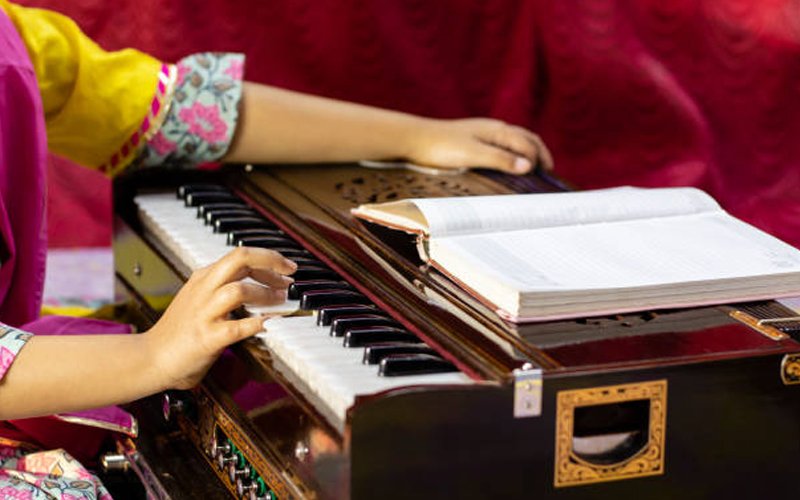
The harmonium is a keyboard instrument with bellows that generate airflow to produce sound. It belongs to the family of free-reed aerophones, similar to the accordion and the pump organ. The instrument consists of a keyboard, which is played with the hands, and a set of bellows that are pumped with one hand while playing.
Construction:
Traditionally, the harmonium has a wooden frame and casing, with metal reeds inside. The bellows are typically made of cloth or leather and are operated by a pedal or handle. The keyboard layout is similar to that of a piano, with white and black keys arranged in octaves.
Playing Technique
To play the harmonium, the player sits in front of the instrument and pumps the bellows with one hand to create airflow. With the other hand, the player presses the keys to produce notes. The keys are pressed and released to create melodies and harmonies, and the bellows are manipulated to control the volume and expression of the sound.
Sound Production
The harmonium produces sound when air from the bellows passes over metal reeds, causing them to vibrate and produce musical tones. The pitch of the notes is determined by the length and tension of the reeds, which can be adjusted using stops or knobs on the instrument.
Musical Uses
The harmonium is used in a wide range of musical genres and contexts. In Indian classical music, it is often used as an accompanying instrument for vocalists and instrumentalists, providing harmonic support and embellishments. It is also commonly used in devotional music (bhajan and kirtan) and folk music traditions.
Learning the Harmonium
Learning to play the harmonium typically involves taking lessons from a qualified instructor who can teach proper technique, fingering, and repertoire. Beginners start with basic exercises and simple melodies, gradually progressing to more complex compositions. Practice is essential for developing proficiency and musical expression on the instrument.
Modern Adaptations:
In addition to traditional acoustic harmoniums, electronic and digital versions of the instrument are also available. These instruments offer features such as built-in speakers, MIDI compatibility, and various instrument sounds. While electronic harmoniums lack the organic sound and tactile feedback of acoustic instruments, they can be more portable and versatile for certain musical applications.
Discover Your Passion: Classes at Rhythmic Studio
Unlock your artistic potential with our diverse music, dance, and art classes at Rhythmic Studio. Join us and let your creativity soar!
Contact us
Share your Details and Query, we will respond shortly.
How to contact us
If you’ve got questions you would like to share, send a message. For anything more specific, please use one of the addresses listed below.
